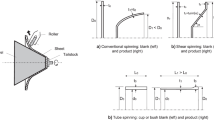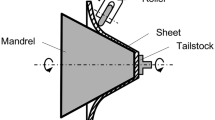Abstract
Incremental tube forming (ITF) is a new process allowing a flexible manufacturing of 2D and 3D bent tubes with load-optimized cross sections by means of the combination of the procedures spinning and bending. The aim of this paper is to acquire an in-depth process understanding concerning the surface roughness. This paper focuses on the spinning process operation of the ITF process. The influence of the spinning roll geometry and the process parameters on the theoretical surface roughness is studied in detail. Crest height h and roughness average parameter R a are formulated as function of process parameters and spinning roll geometry. Also, a fishbone diagram with the parameters influencing the tube surface characteristics is provided. Experiments are performed to quantify the divergences of the equations. The theoretical approach can be used to understand the incremental tube forming process in more detail.


















Similar content being viewed by others
Abbreviations
- f :
-
Feed rate in mm/min
- f r rev :
-
Feed per revolution of 1 roll in mm/rev
- f rev :
-
Feed per revolution (of all the rolls) in mm/(rev*r)
- N :
-
Rotation speed of the rolls in 1/min
- r :
-
Number of spinning rolls
- h :
-
Height of the surface crest
- y :
-
Central line situation
- R a :
-
Roughness average parameter
- R :
-
Radius
- t :
-
Tangency point
- α:
-
Roll chamfer
- αt :
-
Tilt angle
- L m :
-
Measuring length for surface roughness
- Øred :
-
Diameter reduction in percentage
- d :
-
Tube diameter
- x :
-
Diameter reduction
- l :
-
Length of the tube
- ε:
-
Absolute error
- e :
-
Relative error
References
Kleiner M, Geiger M, Klaus A (2003) Manufacturing of lightweight components by metal forming. CIRP Ann Manuf Technol 52(2):521–542
Chatti S (2006) Production of profiles for lightweight structures. Books on Demand GmbH, Germany
Music O, Allwood JM, Kawai K (2010) A review of the mechanics of metal spinning. J Mater Process Technol 210(1):3–23
Vollertsen F, Sprenger A, Kraus J, Arnet H (1999) Extrusion, channel, and profile bending: a review. J Mater Process Technol 87(1–3):1–27
Hermes, M, Kurze, B, Tekkaya, AE (2009) Method and device for forming a bar stock. Patent Application. WO002009043500A1
Hermes M, Staupendahl D, Becker C, Tekkaya AE (2011) Innovative machine concepts for 3D bending of tubes and profiles. Key Eng Mater 473:37–42
Yang WH, Tarng YS (1998) Design optimization of cutting parameters for turning operations based on the Taguchi method. J Mater Process Technol 84(1–3):122–129
Ozel T, Karpat Y (2005) Predictive modeling of surface roughness and tool wear in hard turning using regression and neural networks. Int J Mach Tools Manuf 45(4–5):467–479
Benardos PG, Vosniakos GC (2002) Prediction of surface roughness in CNC face milling using neural networks and Taguchi’s design of experiments. Robot Comput-Integr Manuf 18(5–6):343–354
Tsai Y-H, Chen JC, Lou S-J (1999) An in-process surface recognition system based on neural networks in end milling cutting operations. Int J Mach Tools Manuf 39(4):583–605
Zhang JZ, Chen JC (2009) Surface roughness optimization in a drilling operation using the taguchi design method. Mater Manuf Process 24(5):459–467
Weng Z, Lu B, You H, Ding H, Cai Y, Xu G et al (2009) Experimental study on the influence of the grinding wheel topography on grinding chatter and grinding surface waveness. Key Eng Mater 416:472–476
Liu CH, Chen A, Chen C-A, Wang Y (2005) Grinding force control in an automatic surface finishing system. J Mater Process Technol 170(1–2):367–373
Kuljanic E (1975) Cutting forces and surface roughness in broaching. CIRP Ann 24(1):77–82
Axinte D, Boud F, Penny J, Gindy N, Williams DJ (2005) Broaching of Ti-6-4: detection of workpiece surface anomalies on dovetail slots through process monitoring. CIRP Ann Manuf Technol 54(1):87–90
Ciurana J, Arias G, Ozel T (2009) Neural network modeling and particle swarm optimization (PSO) of process parameters in pulsed laser micromachining of hardened AISI H13 steel. Mater Manuf Process 24(3):358–368
Benardos PG, Vosniakos G-C (2003) Predicting surface roughness in machining: a review. Int J Mach Tools Manuf 43(8):833–844
Martellotti ME (1941) An analysis of the milling process. Trans ASME 63:667
Quintana G, De Ciurana J, Ribatallada J (2010) Surface roughness generation and material removal rate in ball end milling operations. Mater Manuf Process 25(6):386–398
Chang H-, Kim J-, Kim IH, Jang DY, Han DC (2007) In-process surface roughness prediction using displacement signals from spindle motion. Int J Mach Tools Manuf 47(6):1021–1026
Grzesik W (2008) Influence of tool wear on surface roughness in hard turning using differently shaped ceramic tools. Wear 265(3–4):327–335
Gologlu C, Sakarya N (2008) The effects of cutter path strategies on surface roughness of pocket milling of 1.2738 steel based on Taguchi method. J Mater Process Technol 206(1–3):7–15
Brezocnik M, Kovacic M (2003) Integrated genetic programming and genetic algorithm approach to predict surface roughness. Mater Manuf Process 18(3):475–491
Groover MP (2004) Fundamentals of modern manufacturing: materials, processes, and systems, 2nd edn. Wiley, New York
Becker C, Staupendahl D, Hermes M, Chatti S, Tekkaya AE (2012) Incremental tube forming and torque superposed spatial bending—a view on process parameters. In: Proceedings of the 14th international conference “metal forming 2012”, Krakow, Poland, steel research international, pp 159–162
Acknowledgments
This research work is kindly supported by the European Community’s Research Fund for Coal and Steel (RFCS) under grant agreement n° [RFSR-CT-2009-00017] and the German Research Foundation (DFG) (TE 508/26-1). The authors thank Mr. Matusin for his work during the experimental investigations.
Author information
Authors and Affiliations
Corresponding author
Rights and permissions
About this article
Cite this article
Becker, C., Quintana, G., Hermes, M. et al. Prediction of surface roughness due to spinning in the incremental tube forming process. Prod. Eng. Res. Devel. 7, 153–166 (2013). https://doi.org/10.1007/s11740-012-0424-4
Received:
Accepted:
Published:
Issue Date:
DOI: https://doi.org/10.1007/s11740-012-0424-4




